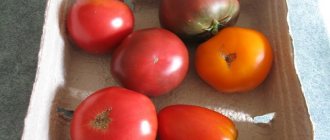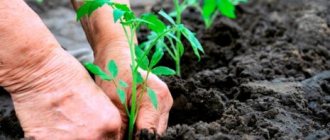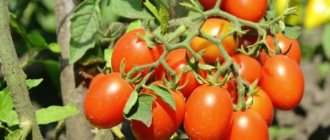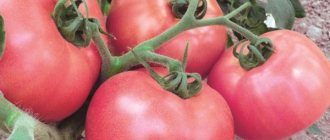The Primadonna tomato is an early-ripening determinate hybrid that is characterized by good yield and ease of care. Therefore, in the time that has passed since its breeding, many Russian vegetable growers have already managed to appreciate this tomato hybrid.
I would like to note that the tomato hybrid Primadonna was bred relatively recently - at the beginning of this century, and was included in the Russian State Register after variety testing in 2007. And during this period, thanks to its improved characteristics, this tomato began to be actively grown by vegetable growers from different Russian regions - in garden beds and in greenhouses.
Fruit characteristics
Ripe tomatoes of this variety look very beautiful - rounded, slightly elongated fruits with sharp noses hang in clusters on the bushes. Moreover, they do not ripen at the same time, so on Primadonna tomato bushes you can simultaneously see ovaries, green fruits, blushing and fully ripened tomatoes.
Small yellow flowers are collected in racemose inflorescences, each of which can form up to 7 ovaries. Up to 6 brushes are formed on each shoot, the first of which appears under the 5th leaf, and each subsequent one appears through a pair of true leaves.
The first fruits are quite large, they can weigh about 180-200 g with an average diameter of about 10 cm. However, the last ripening fruits will be much smaller - up to 100-110 g in weight. This is not a disadvantage of this hybrid; it also occurs in other varieties and hybrids of tomatoes, when the fruits of the last wave of the harvest grow smaller.
Fully ripe tomatoes are rich red in color. Their smooth, shiny skin is of medium thickness and is not prone to cracking, which is a definite advantage of this tomato hybrid.
Also, fully ripened fruits do not have a green spot in the area of the stalk, making the fruits look more aesthetically pleasing.
The pulp of ripe tomatoes is quite compact, deep red in color, with several seed chambers. Since the Primadonna tomato is a hybrid. the seed material in the chambers is in its infancy.
This tomato is distinguished by its high yield - up to 16-19 kg of tomatoes are harvested from each square of area, and up to 8 kg of ripe fruits from each plant.
Since the skin of the fruit is quite dense and not prone to cracking, the harvested crop can easily withstand transportation over any distance and can be stored for quite a long time in appropriate conditions.
General description of the hybrid
Tomato Primadonna is a first generation hybrid. This is indicated by the designation f1. It was entered into the Russian state register in 2007. Since then, this variety of tomato crop has not lost its popularity.
The hybrid was bred by domestic breeders. It is intended for cultivation in the climatic conditions of most regions of our country.
Note! A hybrid is obtained by crossing two varieties. When seeds are planted from their fruits, the grown plants in most cases acquire parental characteristics. To grow the Primadonna tomato constantly, you will have to buy new planting material each time.
Distinctive features of Primadonna tomatoes
The main feature of Primadonna tomatoes is their cold resistance. They are suitable for growing in open ground in the central zone of our country.
The tomato fruits of this hybrid are bright red. They have a round shape with a well-defined elongated tip. Look how the fruits look in the photo.
The berries have a pronounced tomato aroma. They taste sweet with a slight sourness. The inside is meaty, but juicy.
Primadonna are universal tomatoes in gastronomic terms. Suitable for whole canning, fresh consumption, preparation of tomato products and hot dishes, freezing.
The hybrid is resistant to the most common tomato diseases. This reduces the need to treat it with chemicals for preventive purposes.
Main characteristics
The Primadonna tomato is distinguished by its unpretentiousness and productivity. It is suitable for growing both for yourself and for sale.
Characteristics and description of the variety:
| Parameter | Indicators |
| Bush type | Determinant. Grows up to 1.3-1.5 meters. Stops growing after the formation of the superior ovary. The stem is strong, bristly, with a small number of leaves. The leaves are smooth, large, dark green. The first inflorescence is formed above the 8th leaf, the next after 1-2 leaves. The fruits are formed in clusters, each of which produces up to 10 berries. Up to 7-8 brushes appear on one bush. The root system is branched, but not long. |
| Growing method | In the southern and central zones of our country it is recommended for growing in open ground. In the northern regions, the hybrid is planted in a greenhouse. |
| Productivity | High. One plant produces up to 8 kg of berries per season. For 1 sq. m place up to 5 tomatoes. |
| Fruit | Not large. One fruit weighs between 100-130 g. The outside of the pods is bright scarlet with a darker nose. Red and fleshy inside. Each fruit contains about 5 chambers with a large number of seeds. The fruits are fleshy and juicy. The taste is sweet and sour. |
| Transportability | High. The durable skin of tomatoes allows them to be transported over long distances. They can be stored fresh for more than a month. Do not crack. |
| Ripening time | Early ripening hybrid. The first harvest is harvested 3 months after sowing the seeds. In greenhouses it ripens even earlier. |
| Disease resistance | Has immunity to major tomato diseases. They rarely suffer from late blight. |
Advantages and disadvantages
The main advantages of the Primadonna tomato include:
- early fruit ripening;
- good yield even on poor soils;
- this tomato can be grown even in northern regions;
- tomato bushes do not require special care and are unpretentious;
- are resistant to most diseases characteristic of other tomato varieties;
- the harvested crop can be transported to any distance;
- fruits are not prone to cracking;
- the taste of ripe fruits is sweetish with slight sourness;
- collected tomatoes are for universal use.
The disadvantages of tomatoes include:
- bushes are very tall, so in greenhouses no more than two bushes are usually planted per square area. However, not all greenhouses have enough space to grow this variety;
- This tomato is a hybrid, so it is useless to collect seed material from ripe fruits - it must be purchased annually in specialized stores.
Diseases and pests
This hybrid has high immunity, so the Primadonna tomato is not susceptible to most of the main diseases characteristic of other tomato varieties, in particular:
- verticillium;
- late blight;
- Alternaria;
- cladosporiosis;
- mosaic of tomatoes.
It is also not damaged by pests.
However, for disinfection and preventive purposes, seed material should be soaked for half an hour in a light solution of potassium permanganate before sowing. But potassium permanganate is often replaced with the following drugs:
- warm 3% hydrogen peroxide solution;
- 1% acetic acid solution;
- boric acid;
- copper sulfate.
INTERESTING TO KNOW!
Reasons why leaves on tomatoes dry and turn yellow
To prevent attacks by “harmful” bugs, Primadonna tomato bushes are treated with an insecticide solution several times a season.
Advice!
The following measure is effective against nematodes: calendula and marigolds are planted between rows. The roots of these flowers produce a special substance - theophene, which is capable of killing “harmful” bugs.
Table – varietal characteristics of Prima Donna
Property Name | Tomato Primadonna F1 |
| Purpose | Salad |
| Growing regions | All regions of the country |
| Manufacturer country | Russia |
| Place of cultivation | Vegetable beds Greenhouse conditions |
| Ripening time | 3 months from the moment of seed germination |
| Mass of tomatoes | Up to 140-150 g |
| Shoot height | 1.2-1.3 m |
| Yield indicator per square area | 17-18 kg |
| Disease resistance | TMV, Alternaria, Verticillium, late blight, cladosporiosis |
| The need for a garter | During the period of fruit ripening, shoots must be tied to strong supports so that they do not break under the weight of the fruit. |
Feeding tomatoes Primadonna
Tomato bushes should be fed Primadonna several times a season.
–
a couple of weeks after transplantation, before flowering begins, during the formation of ovaries and during the ripening of fruits.
The last feeding is carried out a couple of weeks before the start of tomato harvesting.
Fertilizers applied to Primadonna tomato bushes should contain superphosphate and potassium salts.
Features of cultivation and care rules
Tomato Primadonna F1, like other tomatoes, is grown in seedlings. To do this, seed material should be planted at home approximately 55-60 days before the intended transplant to garden beds or greenhouse conditions.
Growing and planting seedlings
For growing tomato seedlings at home, wide, fairly long containers that are pre-disinfected are suitable, especially if they are used for growing seedlings annually.
Soil is usually purchased in specialized stores, and you need to buy special soil for growing vegetable seedlings. However, some summer residents prefer to prepare a nutritious soil mixture at home.
The easiest way to prepare the following nutrient substrate:
- mix turf, humus and peat, taken in equal parts;
- add superphosphate (a couple of matchboxes) and 500 g of wood ash to 10 liters of the prepared mixture;
- All ingredients are thoroughly mixed.
Such a nutrient substrate must be disinfected before being placed in containers. To do this, it is steamed in a water bath for half an hour. After the soil has cooled, it can be used for planting seed.
The seeds are buried 1-1.5 cm into the soil, then watered and the containers are covered with polyethylene to create a greenhouse effect inside. In such conditions, seed material germinates faster - in 5-6 days.
After friendly shoots appear in the containers, the film should be removed and the plants should be moved to a bright place. In order for seedlings to grow actively, they should be watered regularly so that the top layer of soil is constantly moist, but the moisture in the soil does not stagnate.
When the plants have several permanent leaves, they should be picked. It is advisable to plant the seedlings in peat pots, then when transplanting the tomato into the beds you can plant them together with the container. Peat pots in the soil will gradually decompose and serve as additional fertilizer, and the roots of the plants will not be damaged during replanting. As a result, the seedlings acclimatize faster in the beds and begin to actively develop.
A couple of weeks after the picking procedure, you can feed the Primadonna tomato seedlings with a solution of urea or other fertilizer containing nitrogen. If necessary, fertilizing with this fertilizer can be repeated after 10-12 days (but no later than 2 weeks before transplanting to the beds).
Approximately 12-14 days before transplanting the seedlings, they should be hardened off by taking the plants out into the fresh air for a short time at first, but gradually the time outside for tomato seedlings should be increased.
Tomato seedlings are ready for transplanting if they have at least 5 permanent leaves and the stem height has reached 14-16 cm. It is possible that the first inflorescence has appeared on them.
Tomato transplant
Before the grown seedlings are moved to a permanent place, it needs to be prepared. The selected sunny area, protected from wind and drafts, must be cleared of remnants of vegetation, fertilized with humus or compost and dug up, incorporating organic matter into the soil.
Important! When planting, mineral fertilizer containing phosphorus and potassium is added to the prepared holes.
Planting holes are dug in rows, the direction of which should be from north to south. The distance between holes in a row is 0.4 m, and between rows - 0.5 m. Usually, no more than 5 Primadonna tomato bushes are placed on a square of area.
At the same time, you should consider how the garter of grown shoots will be done in the future.
After planting, the plants are watered, adding 3-4 liters of water under each bush.
Mulching
After watering, many experienced vegetable growers recommend covering the root zone of tomatoes with a layer of mulch 4-6 cm thick. Humus, sawdust, straw, and fallen leaves can be used as mulching elements.
A layer of mulch prevents moisture from quickly evaporating from the soil and also prevents the growth of weeds. In addition, organic matter gradually rots and serves as an additional fertilizer for plants.
Watering and fertilizing
In the first 6-8 days after transplanting the seedlings, tomatoes are watered daily in the evenings with settled water strictly at the root. Then watering is carried out as the top layer of soil dries. After each watering, you need to loosen the beds to break up the dry crust that appears, while simultaneously destroying all weeds.
You should also feed tomato bushes during the summer season with fertilizers containing potassium and phosphorus. The first such feeding is carried out 12-15 days after transplanting the plants into the beds. Then fertilizers are applied every 14-18 days until fruiting begins.
Stepsoning
Appearing stepsons need to be regularly removed, since the Primadonna tomato is usually grown with no more than 3 stems. Therefore, a couple of stepsons are left on each bush, from which side shoots will grow, and the rest are constantly pruned.
Tying up
Since the Primadonna tomato bushes grow quite tall, you need to install strong supports next to them in order to tie up the shoots with the fruits ripening on them. A lot of tomatoes form on the bushes; if the stems are not tied up, they can break under the weight of the ripening fruits.
In greenhouse conditions, trellises are usually installed for gartering tomatoes.
Features of growing in open and protected ground
Seedlings can be transplanted into a greenhouse 12-14 days earlier than in open ground.
Particular attention should be paid to soil and environmental moisture - if moisture stagnates, tomatoes can be affected by fungal diseases. And when growing this vegetable plant in greenhouse conditions, after each watering you need to ventilate the greenhouse so that the humidity in the room does not increase.
Pest and disease control
Tomato Primadonna is highly resistant to many diseases, in particular to:
- verticillium;
- late blight;
- Alternaria;
- cladosporiosis;
- mosaic of tomatoes.
To protect these vegetable plants from diseases, the seed material is placed in a weak solution of potassium permanganate for half an hour before planting.
During the summer season, for preventive purposes, Primadonna tomato bushes are sprayed with an insecticide solution to prevent the appearance of harmful insects.
Advice! It is recommended to plant marigolds or marigolds between the rows, which repel nematodes with their aroma.
Errors during cultivation
Although the Primadonna tomato is unpretentious and does not require special care, if the rules of cultivation are violated, this tomato can be affected by certain diseases.
It is important, first of all, to observe the irrigation regime, since excess moisture, as well as its lack, can cause deterioration in yields and the occurrence of fungal diseases. Water for irrigation must be left in the sun so that it heats up at the same time. Excessive watering with cold water can lead to the development of root rot.
Although the Primadonna F1 tomato can grow and bear fruit even on poor soils, it would still be a mistake not to fertilize at all. The main thing is that the last fertilizers are applied before the fruits begin to develop on the bushes.
Tomato Primadonna F1: description from the manufacturer
An early-ripening, high-yielding hybrid with high fruit set, 120-130 cm high, for growing in film greenhouses and open ground. The fruits are selected, red, round, with a spout, dense, fleshy, transportable, weighing 170-200 g, with high taste and commercial qualities. Value of the variety: cold resistance, high yield even with sudden temperature changes, fruit density, marketability.
Seeds for seedlings are sown in March - early April, to a depth of 1 cm. Picking in the phase of 1-2 true leaves. Seedlings are fed 2-3 times with complete fertilizer. 7-10 days before planting, seedlings begin to harden. 60-65-day-old seedlings are planted in greenhouses in April - May, in open ground - in June, after the end of spring frosts, in the phase of 6-7 true leaves and at least one flower cluster, according to a 30x50 cm pattern. As the lower leaves age they must be removed, this will speed up the ripening of fruits, increase yield, and prevent the development of fungal diseases.
Recently searched:
Harvesting
Tomatoes are collected as they ripen, then new ovaries will form more actively on the shoots, and green fruits will ripen faster.
The harvested crop is used for fresh consumption - salads and various snacks are prepared. Tomatoes of the Primadonna variety are also used to make preparations for the winter. They make delicious ketchups, sauces, winter salads, and lecho.
Planting seeds
Drainage (shell rock, small pebbles, crushed expanded clay) is poured into the bottom of the container for seedlings. The prepared soil is poured on top.
Make grooves in the soil 1 cm deep at a distance of 3 cm from each other. Seeds are grown in them at intervals of 2 cm. After this, the depressions are covered with earth.
The soil is moistened with a spray bottle with warm water, covered with film or glass and placed in a warm place. The warmer the room, the faster the seeds will germinate. Often boxes with planting material are placed near the battery.
This is interesting ! Many gardeners prefer to grow seedlings the Chinese way. Its peculiarity is that the planting material is placed in a cold place for several days. Seeds are sown during the waning moon, located in the constellation Scorpio. Plants sprout in exactly one month.
Seedling care
To get healthy and strong plants, great attention needs to be paid to caring for the seedlings. The list contains the basic rules:
- After seed germination, the boxes are moved to a well-lit place. The film is removed after a week.
- Water tomatoes only at the root. Water should not fall on the above-ground part of the plant. For immature sprouts, use a pipette or syringe. After picking, water the tomatoes from a watering can or bottle. Use warm, settled water.
- Seedlings are picked after the first true leaves appear. Most gardeners do not advise pinching the central root, which is already damaged during transplantation.
- After picking the plants, the first fertilizing and watering are carried out no earlier than a week later.
- During the period of growing seedlings, three feedings are made. To do this, use complex fertilizers or vermicompost. For one plant, take half the portion indicated on the package. The last time tomatoes are fed is a few days before they are planted in a permanent place.
- Two weeks before transplanting, the plants begin to harden off. To do this, they are taken out to the balcony or outside, gradually increasing the time spent in the fresh air.
Reviews from those who planted
Natalya, 55 years old, Samara region: I have been growing the Primadonna tomato for several years. My family loves the delicious sour-sweet fruits of this tomato, not only fresh, but also salted or pickled. I’m also happy that this tomato is unpretentious, since we can only come to the dacha on weekends. Despite the fact that the bushes of this tomato do not receive proper care during weekdays, their yield remains consistently high.
Maria, 44 years old, Barnaul: in our region the weather is unpredictable, so not all varieties and hybrids of tomatoes can be grown. The Primadonna tomato grows well and bears fruit in my greenhouse; I consistently collect at least 7 kg of ripe fruits from each bush per season. We have enough harvested crops not only for food. but also for twists.
Olga, 30 years old, Volgograd region: I grow the Primadonna tomato every year. I really like that the variety is resistant to most diseases, so it does not have to be treated with fungicidal preparations to treat late blight or other fungal disease.
The Primadonna tomato is one of the best salad hybrids that can be grown in all Russian regions on any soil in greenhouses and in the garden. At the same time, its productivity remains consistently high, and the fruits are tasty. Since this tomato is unpretentious, even novice gardeners can grow it.
Growing seedlings
Tomato seedlings begin to be grown two months before they are planted in open ground. In most regions, seeds are sown in March.
Before sowing planting material, you should familiarize yourself with the lunar calendar. It is believed that tomatoes planted on the correct lunar day germinate faster.
Seed preparation
Before planting the seeds, they are sorted out. Dense, light-colored seeds without stains or damage are suitable for use. It is important to check the expiration dates on the packaging.
Disinfecting seeds will prevent diseases from infecting plants. Usually, for these purposes, planting material is soaked for half an hour in potassium permanganate, diluted in a ratio of 1 g per 10 ml. After soaking, the seeds are washed under running water.
To speed up seed germination, they are soaked in growth stimulants or other methods are used.
The list contains the most common of them:
- Purchased drugs . Most often, Epin or Fitosporin are used to stimulate growth. Seeds are processed as indicated in the instructions on the package.
- Folk remedies. The most effective are: aloe juice, diluted in a 1:1 ratio with water, a soda solution, for the preparation of which you need to take 1 teaspoon of soda per glass of liquid, honey solution, prepared from 1 teaspoon of honey and a glass of water. Planting material is soaked in such stimulants for 12 hours.
- Plain water. To use this method, pieces of gauze are moistened in clean water. The seeds are wrapped in them. The fabric with the seeds is placed in a saucer, which is covered with film and placed in a warm place. The seeds are left in this form until germination. This takes 2-3 days.
Selection of soil and containers
To grow tomatoes you will need the right containers. This determines how comfortable the plants will feel.
For sowing seeds, choose large but shallow containers. It is not necessary to use special trays and boxes.
Pots are often made from scrap materials:
- instant noodle trays;
- plastic containers for herring and seafood;
- cake packaging;
- plastic disposable tableware;
- cut six-liter bottles.
For picking plants, use containers with a volume of 300 ml. Stores sell special plastic and peat pots. Often, disposable cups and cut-off bottles are used for planting seedlings.
All containers are disinfected before use. To do this, they are soaked for half an hour in a strong solution of potassium permanganate.
Soil for tomatoes is no less important than containers . You can buy it at a gardening store or make it yourself. In any case, soil mixtures are treated with high temperatures or a solution of potassium permanganate.
To prepare the soil for tomatoes, mix chernozem with humus in different proportions. Ash and “Superphosphate” are added to the mixture. To make the soil lighter, add one part of sand, sawdust, peat or crushed coconut fiber.
Tomato care Primadonna
When caring for growing Primadonna tomato bushes, you should adhere to the watering regime, after each watering, loosen the soil while simultaneously removing weeds. Then you can mulch the soil around the bushes so that the moisture evaporates more slowly.
During the growth process, Primadonna tomato bushes require obligatory garters to strong supports; it is better to use synthetic twine, which does not injure the shoots as much as twine made from twisted paper.
It is also necessary to occasionally remove excess shoots, as well as some of the foliage that shades the fruits and interferes with their ripening.
Photo
Tomatoes of the Primadonna variety can be seen in the photo:
Below are a couple of photos of the Primadonna variety bush:
Useful video
You can watch a brief overview of the tomato variety “Primadonna” F1 in the following video:
In the table below you will find links to tomato varieties with different ripening periods:
| Early ripening | Mid-late | Mid-early |
| Pink fleshy | Yellow banana | Pink King F1 |
| Ob domes | Titanium | Babushkin |
| King of the Early | Slot F1 | Cardinal |
| Red Dome | gold fish | Siberian miracle |
| Soyuz 8 | Raspberry miracle | Bear Paw |
| Red icicle | De Barao red | Bells of Russia |
| Honey cream | De Barao black | Lev Tolstoy |
All the pros and cons: is it worth planting?
The Primadonna variety has a lot of advantages:
- unpretentious;
- resistant to fungal diseases;
- ripens quickly;
- not subject to rotting processes;
- has high productivity;
- can be stored for a long time;
- successfully transported.
See also Which tomatoes to plant in a polycarbonate greenhouse: the best varieties and recommendations for growing
If we talk about shortcomings, it is worth highlighting the height of culture. Not every greenhouse has the opportunity to grow tomatoes that grow 1.2 m upward. Also, the seeds of the species are not collected for sowing the next season due to the fact that they will not inherit the properties of the mother crop.









